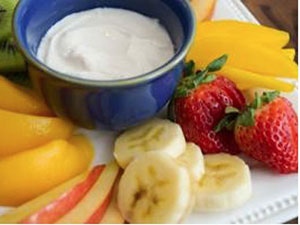Seize the Snack!
Jessica Clifford, MS, RDN, CSU Extension Nutrition Specialist.
Adapted by Glenda Wentworth Family &Consumer Science Extension Agent

Snacking continues to be on the rise. A vast majority of us eat a snack at least once or more throughout the day.We also tend to allow our children to graze throughout the day without giving much thought to it. Snacking is just as important as breakfast, lunch, and dinner. Because snacks are being consumed more frequently we need to be mindful of the snacks
we feed our children.
Children are very active and their energy needs are high. In addition to that, children?s small
bodies have a limited capacity for food. So they need to eat every 2 ? 3 hours. Grazing is becoming
commonplace in our homes; however, a more structured eating pattern is best for young
children. A satisfying healthy and nutritious snack is an important part of a child?s daily eating
pattern. A snack should be offered midway between meals so your child is not famished before the next meal. It should be offered long enough after the previous meal so your child has time to get hungry, but not too hungry. A snack should be offered long enough before the next meal so your child will be comfortably hungry in time for the next meal. Therefore, a planned and consistent snack time is helpful for your child to curb their hunger in between meals. or your child.
To help curb your child?s hunger from one meal to the next, snacks should contain a variety of foods and beverages from each food group (whole fruits, vegetables, whole grains, lean protein, and dairy/calcium). Serve whole grain bread or crackers with cheese, peanut butter, or a glass of milk. Serve fruit with cheese, cottage cheese, yogurt or milk. Vegetables can be served raw or cooked with a dip or some form of meat, fish or poultry. A carrot dipped in hummus is a great snack. Another option is a smoothie coupled with some whole grain bread or crackers. Remember to offer water for thirst with meals and snack times as well as in between.
Let’s Talk
Have your child sit at a table to eat snacks. It helps to be mindful of eating and establishes good habits.
Don?t allow your child to run around the house with food in hand. This is unsafe as your child could choke. It may also cause us to eat mindlessly and possibly overeat.When not paying attention to what we are eating, we can miss out on the enjoyment and taste of food.
Try to make this a time you sit down with your child. It is more relaxing and it helps to keep things calm. It also teaches them to enjoy their food.
Snacking can be a great way to have healthier foods if we make wise choices about what, when, and how our children snack.
Recipes for Health:
Fruit Dip

Ingredients:
-
- 1cup yogurt, non-fat vanilla (8 oz.)
- 1fluid ounce orange juice, 100% juice, frozen concentrate (thawed)
- 1tablespoon lime juice
- 11/2 teaspoons brown sugar, optional (1/2 tablespoon)
- Fruit such as:
- 2 apples (cored and sliced, peeled if necessary)
- 1pear (cored and sliced, peeled if necessary)
- 1peach (pitted and sliced, peeled if necessary )
- Sliced bananas
- Sliced strawberries
- Sliced mango
- Sliced kiwi
Directions:
- In a bowl, combine yogurt, orange juice concentrate, lime juice and brown sugar.
- Mix well.
- Place dip into small bowls, serve on a plate and surround with fruit.
- To round out the snack; add some whole grain crackers or bread.
https://whatscooking.fns.usda.gov/recipes/supplemental-nutrition-assistance-program-snap/fruit-dip





